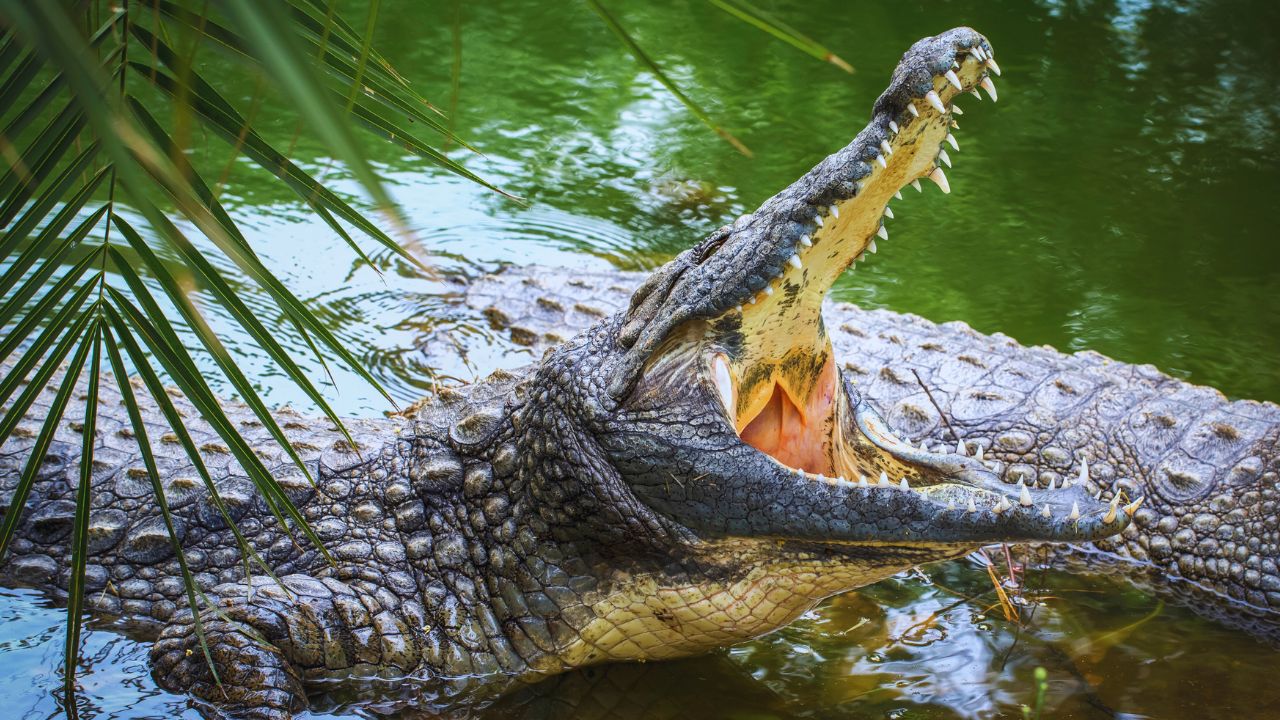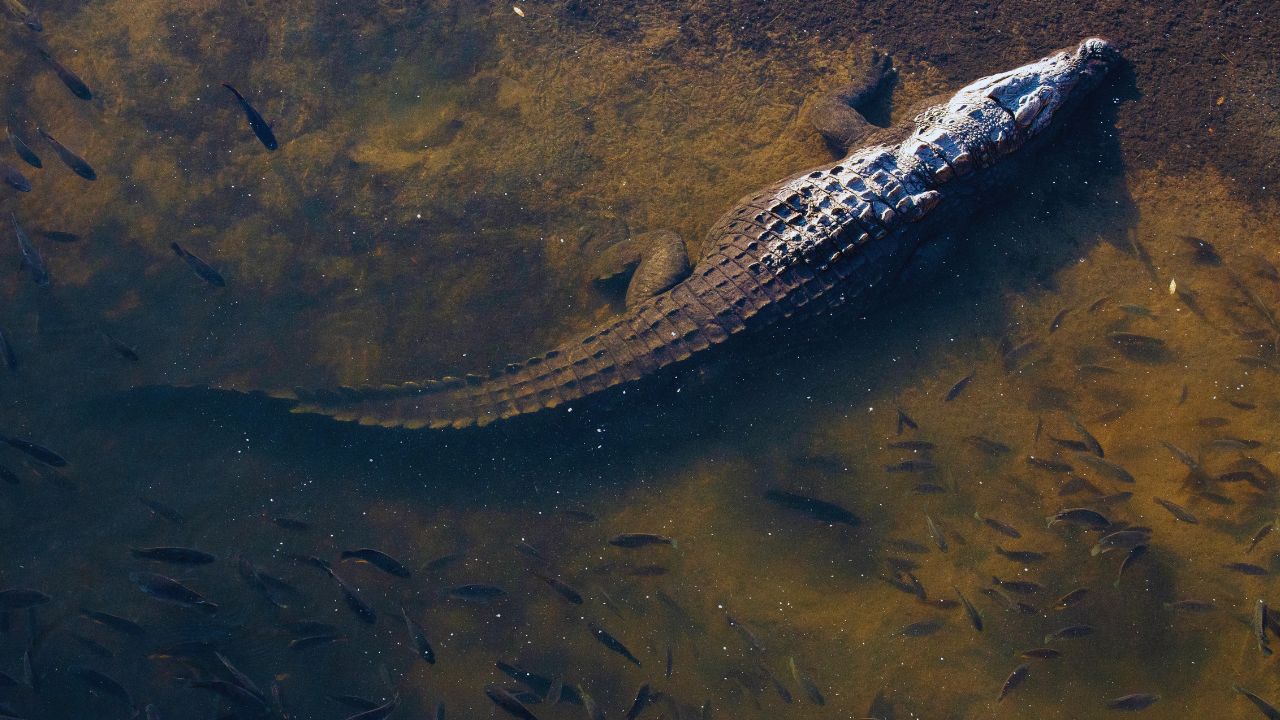Discovering the Entertaining World of Crocodiles
Apex predators that ruled the food chain around 100 million years ago, crocodiles still astonish and terrify us to this day. With their massive jaws and robustly formed bodies, these intimidating reptiles give off an impression of threat and dominance. Even with their hundreds of millions of years of ancestry, crocodiles are still mysterious in many respects. For example, did you know that old age cannot kill crocodiles?

Crocodile Characteristics and Facts
| Feature | Details |
|---|---|
| Species Count | 14 |
| Smallest Species | Dwarf Crocodile (4.9 feet, 40–71 pounds) |
| Largest Species | Saltwater Crocodile (23 feet, 2,200–2,600 pounds) |
| Bite Force | Over 5,000 pounds |
| Hearing and Vision | Excellent; specialized sensors on jaws, adapted eyes for low-light conditions |
| Swimming Speed | Up to 20 miles per hour in short bursts |
| Breath-Holding Capacity | Up to 2 hours |
| Relation to Birds | Closer than to other reptiles, both descended from prehistoric archosaurs |
| Evolutionary History | Minimal changes over millions of years, considered living fossils |
| Lifespan in Wild | 25-70 years |
| Lifespan in Captivity | Up to 100 years |
| Aging Process | Do not die of old age; continuous growth until death caused by external factors |
| Microbiome Research | Crocodile serum shows inhibitory effects against cancer cells, potentially aiding anti-aging |
The Myth surrounding crocodiles
Semi-aquatic reptiles, such as crocodiles, are found in wetlands all over the world, with the exception of Europe. Being the biggest reptiles on Earth, their cold-blooded nature means they cannot produce their own heat, so they do best in tropical conditions. Due to this dispersion, fourteen different crocodile species have evolved, each of which is suited to a certain habitat.
The Dwarf Crocodile is the smallest of these species, growing to a length of about 4.9 feet and a weight of 40 to 71 pounds. The biggest species, the Saltwater Crocodile, on the other hand, may reach a maximum length of 23 feet and a staggering weight of 2,200 to 2,600 pounds. The biting force of crocodiles is well known; bigger specimens have the ability to bite with a force greater than 5,000 pounds, which enables them to seize and devour a wide range of animals. Being carnivores, meat makes up the majority of their diet.
Five Interesting Things to Know About Crocodiles

One of the most fascinating animals in the animal realm are crocodiles, who are well-known for their formidable reputation, strong jaws, and sharp teeth. But these prehistoric reptiles are much more complex than first seems. The following are five fascinating crocodile facts:
Strongest biting Force in the Animal Kingdom: With a biting force of up to 3,000 pounds per square inch, crocodiles have the strongest bite force of any animal. They can easily break bones and dismember victims because to their immense strength.
Superb Hearing and eyesight: Although they may seem lethargic, crocodiles have very good hearing and eyesight. Their eyes are designed for low light, so they can hunt efficiently in the dark. They also have specific sensors on their jaws that let them feel vibrations in the water.
Competent Swimmers: Crocodiles have strong swimming abilities and can accomplish brief sprints of up to 20 mph. They can also stay underwater for lengthy periods of time when pursuing prey since they have the ability to hold their breath for up to two hours.
Close Relatives of Birds: Although crocodiles are sometimes categorized as reptiles, their kinship with birds is greater than that with other reptiles, such as lizards and snakes. Birds and crocodiles are descended from the same ancient archosaur family.
Living Fossils: Millions of years have passed since the emergence of the crocodile. Since crocodiles have not changed much throughout the course of evolution, according to fossil data, they may be considered living fossils.
The Life Cycle of Crocodiles

The life cycle of the majority of crocodile species is similar and consists of four main stages:
Stage of the Egg
The average female crocodile builds one nest a year, maybe more, depending on how she is feeling. These nests might be big and isolated or made up of many smaller nests near each other. The eggs are laid by females in groups of 30 to 60, and they take 80 to 90 days to hatch. The sex of the hatchlings is determined by the temperature of the nest during incubation.
Stage of Hatchling
Regretfully, a large percentage of juvenile crocodiles do not reach maturity. Frequently, predators will feast on eggs or they may be lost to floods. When hatchlings do emerge, their moms zealously guard them until they are mature enough to take care of themselves. Hatchlings need four to fifteen years to reach full maturity.
Stage of the Young Crocodile
For their development, young crocodiles need a diet high in meat. They progressively transform into their adult forms throughout this period. An American crocodile, for example, has four short legs and a muscular tail, and its body grows more robust and lizard-like. As they get older, their originally rough and scaled skin turns a uniform brown color with darker cross-bands on the body and tail.
maturity
At the age of ten or so, crocodiles attain sexual maturity and may grow to a length of five to ten feet. Adult crocodiles are nocturnal predators that hunt at night and thermoregulate during the day by switching between sunbathing and hiding in the shade.
| Life Cycle Stage | Description |
|---|---|
| Egg Stage | Female lay 30–60 eggs per nest; incubation period is 80–90 days; temperature affects hatchling sex |
| Hatchling Stage | High mortality rate due to predation and flooding; hatchlings are cared for by mothers |
| Young Crocodile | Growth through meat consumption; gradual morphological changes over 4–15 years |
| Adulthood | Reaches sexual maturity at around 10 years; nocturnal hunting; thermoregulation behaviors |
The Lifespan of an Average Crocodile
The Saltwater Crocodile is the longest-living species of crocodile in the wild, with a lifespan of up to 70 years. However, lifespans may range from 25 to 70 years, depending on the species. It’s interesting to note that crocodiles kept in captivity have lived to be 100 years old.

The distinctive aging process of crocodiles distinguishes them from many other species. The biological aging process does not kill crocodiles. Rather, they keep growing all the way through life until something outside of them kills them. Much study has been done on its amazing anti-aging property. The gut microbiota of crocodiles may be involved in this phenomenon, according to research by Siddiqui, Ruqaiyyah, et al. titled “Longevity, cellular senescence, and the gut microbiome: lessons to be learned from crocodiles.” The results of the research showed that crocodile serum had strong cytotoxic and growth-inhibitory effects on cancer cells, suggesting that the gut microbes of these animals may contribute to the inhibition of cancer cell survival.
Because of their remarkable ability to fight aging, crocodiles are often referred to as living fossils. Their longevity is still a little bit of a mystery. Let’s take a closer look at the crocodile’s life cycle to get a better idea.
Factors Affecting the Lifespan of Crocodiles
With few natural enemies, crocodiles are apex predators. However, a number of things, including as poaching, habitat deterioration, and human involvement, might shorten their longevity. Crocodile populations are being threatened by poachers who hunt them for their prized skin.
| Factor | Impact on Lifespan |
|---|---|
| Natural Predators | Few natural enemies, apex predators |
| Human Threats | Poaching for skin, hunting |
| Habitat Degradation | Deforestation, wetland drainage, and increased human-crocodile conflicts |
| Aging | Tooth loss and cataracts impair hunting abilities |
| Microbiome Effects | Potential inhibition of cancer cell survival, contributing to anti-aging traits |
Crocodile populations are also impacted by habitat deterioration, which is brought on by human activities like wetland draining and forestry. Crocodiles are compelled to live closer to people as their native habitats become smaller, which increases conflict and mortality rates for both parties.

Crocodiles are not immune to the consequences of age, even if they are resistant to biological aging. As they age, they can have tooth loss, which would make it more difficult for them to hunt and feed and finally result in death. They also have a tendency to acquire cataracts, which further impedes their hunting capabilities.





